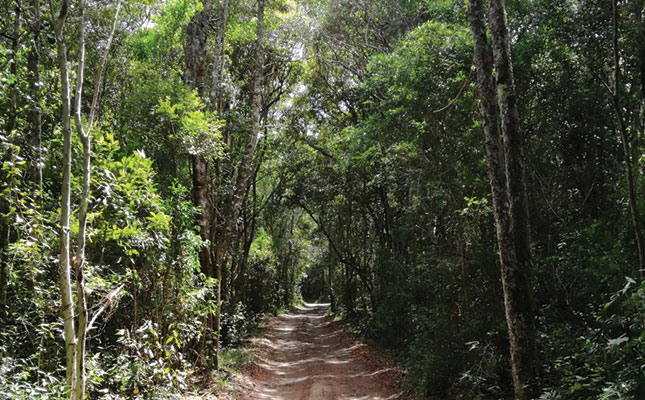Wood is a valuable renewable resource that is used widely across various sectors, from the paper, textile and bioelectronic industries to construction and mining. When plantations are harvested sustainably for their resources, they provide economic, environmental, cultural and human-health benefits.
Pest-control strategies form a vital part of sustainable forest management. South Africa is a global leader in this regard, with 80% of the country’s timber plantations certified by the international Forest Stewardship Council.
Compared with conventional agriculture, South African forestry uses minimal quantities of pesticide, relying instead on cultural practices and biological control, as well as breeding resistant trees and pheromones.
This has been achieved largely through close partnership between forest entomologists at the University of Pretoria (UP) and foresters in the industry.
The forestry industry is a major contributor to South Africa’s economy, as it produces about 18,2 million cubic metres of wood annually with an estimated value of R40 billion.
Commercial forest plantations in South Africa consist mainly of Eucalyptus, pine and wattle.
Unfortunately, these highly productive tree species are vulnerable to attack by indigenous and introduced insect pests.
Biological control
One of the most sustainable and environmentally friendly ways of controlling an insect pest is to introduce its natural enemies into the area. These can include insect diseases, predators and parasites, which can significantly reduce the pest population.
Approximately 20 years ago, forestry companies teamed up with forest pathologists and entomologists at UP to identify environmentally friendly pest-control strategies for forest plantations. This partnership has led to important changes to how pests are managed.
Researchers at UP have identified biocontrol agents for most of the important plantation pests in South Africa. These agents are studied in quarantine laboratories before being released into the field to ensure they do no harm to native insects. After their safety has been established, they are mass-reared in the laboratory, then released in timber plantations where high levels of the pest insects occur.
In some cases, such as with Selitrichodes neseri, the parasitic wasp of the bluegum chalcid, a few releases in 2012 were sufficient for the wasp to establish in some Eucalyptus-growing areas.
This provided effective control of the pest in subsequent years. In other cases, such as with Deladenus siricidicola, the parasitic nematode of the Eurasian woodwasp, regular releases of the biocontrol agent were required. For this reason, rearing facilities, which provide sufficient nematodes each year for efficient control of this insect pest, were established at UP.
UP forest entomologists often travel to the native lands of insect pests to find new biocontrol agents that have better survival traits. The next expedition will visit Southeast Asia to identify biocontrol agents that can be deployed against the polyphagous shothole borer, which is killing native and indigenous trees in cities and landscapes throughout South Africa.
Volatile signals
Insects communicate with each other by smell. The volatile chemicals released by insects to attract a mate or signal fear or other important information are known as pheromones.
Pheromones can also be used to confuse insects and disrupt their mating behaviour, and are an important way to manage pests in plantations.
Researchers at UP recently identified the mating pheromone of the Eucalyptus cossid moth, which is indigenous to South Africa but has switched its host and is now a major pest of cold-tolerant Eucalyptus species. The pheromone is used by the forestry industry for monitoring the pest in plantations and for mass trapping.
UP scientists are producing the pheromones, designing dispensers to release the pheromone in a controlled way, and working out the optimal placement of traps to maximise insect capture.
Tree breeding for resistance
Plants have evolved ways to ward off insect feeding by producing protective measures such as scales, thorns, resin or noxious chemicals. During the past 100 years, tree breeders have focused mainly on improving productivity and wood quality, and neglected defences against insect attack.
This is why many tree varieties grown in South Africa are particularly susceptible to insect damage. In response, forest entomologists at UP have started screening tree varieties for their resistance to insect feeding and have identified a number of chemical traits.
The Eucalyptus snout beetle (Gonipterus scutellatus), for example, which is a major pest in Eucalyptus plantations worldwide, prefers to feed on leaves with a high sugar and low fat content.
Tree breeders are now using this information to select new varieties with low sugar and high-fat content to develop planting stock for future plantations. A new greenhouse facility has also been built at UP to determine the resistance of tree varieties and the reasons for this resistance.
Knowledge exchange
A close partnership between the industry and researchers has sped up investigation into economically relevant industry problems as well as the implementation of new management strategies in the field. The close connection between UP and South Africa’s forestry industry is fostered by entomologists working in the plantations and inviting foresters for research days at the university.
UP’s partnership has also created opportunities for the employment of entomology students, and for them to learn from the industry and make an impact through their research projects.
Email Liesel Swart at liesel.swart@up.ac.za.



